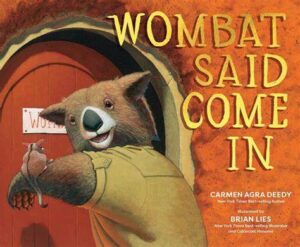 Wombat Said Come In
Wombat Said Come In
Author: Carmen Agra Deedy
Illustrator: Brian Lies
Peachtree
6 October 2022
48 pages
This month’s PB review is by Ryan G. Van Cleave (Owner/Operator of Only Picture Books) and Ringling College of Art and Design Illustration Professor (and OPB pal) David C. Gardner.
–Ryan’s Review of the Writing–
Give most writers a story about hiding out from an Australian brushfire and you might have a scary story. Not so with Wombat Said Come In. From the start, Carmen Agra Deedy is playing with language as you can see with the sound repetition in “Wombat was not worried,” or “Walleeooooo, Wombat!” That’s fun. And to ensure young readers aren’t worried, there’s “Fire had passed over his burrow before.” Whew. That distances the danger even more, so we can focus on the “crazy quilt” or the tea and cookies in Wombat’s hands.
The story quickly becomes one of constant interruptions. First, Wallaby hops by because he can’t get safely back to his own home. Whether you recall the title or not, of course Wombat invites Wallaby inside his cool, safe underground home. Soon, we’ve got Kookaburra, Platypus, Koala, and Sugar Glider joining the group–one after another–in the safety of Wombat’s home.
Worse, they’re making a mess, sleeping in his quilt, wearing his slippers, and using his handkerchiefs. The art does a splendid job of showing how displeased Wombat is growing. Eventually, “days passed,” and finally it’s safe to go outside. Wombat might like the guests, but he says it plainly: “GO HOME! It’s safe for you to rove and roam, and time for me to be alone. Skedaddle! Shoo! Go home!”
That seems like the end of things, but Sugar Glider (who is oh-so-cute in the art) says, “No home-home to go to-to.” So, of course, Wombat responds with, “Come in.”
It’s a story of gentleness and generosity, though it’s also about setting limits. You could also easily use this story as a launching point for discussions on gratitude, patience, and how house guests should behave. I’m also a fan of how this book quietly presents the challenges of dealing with a natural disaster without letting that aspect overpower the story.
There’s a lyrical read-aloud quality to this book, too, that will help make young readers want to hear Wombat’s story again and again. Perhaps Wombat’s inviting refrain will inspire others to be equally generous in times of need.
4.5 out of 5 pencils
–David’s Review of the Illustrations–
Acclaimed author Jane Yolen maintains that the best children’s book illustrations don’t just decorate the book. They deepen it.
Brian Lies does just that in Wombat Said Come In. He wordlessly builds anticipation and sets the scene for the story even before the title page. In a clever cross-section of Wombat’s underground home, Wombat is reading in his cozy den. You could spend an afternoon exploring the illustration’s charming details, a Lies trademark. Next, a double spread takes a striking high-angle view of the path leading up to Wombat’s front door. In the red Australian soil, assorted animal tracks suggest the animals we’ll encounter by the end of the book. A welcome mat is an important detail. The single image conveys one of the themes: All are welcome here.
In addition to his use of clever, fresh, and surprising details, Lies is known for his capturing of light, which is especially strong throughout. His technique of layering acrylics and sculpting with light and shadow, using vibrant colors so delicious, I had to catch my breath at a few page turns. The light is so convincing at times, the characters seem to leap off the page.
When the story begins, Wombat answers the door with his comfy quilt and cookies and tea, which makes the interruption of all his animal neighbors all the more disruptive and funny. The pictures are consistently lighthearted, painted in vibrant jewel tones. Lies conveys Wombat’s growing frustration amidst his neighbors’ chaos with a light touch, so the character never comes across as mean. And the fire blazing outside is never shown, only indicated by smoke, so the book is never scary.
Every page is fun. The pictures bounce with variety, inventive layouts, and plenty of action. They send us tumbling forward along with Wombat, building to the requisite climactic party scene, a striking spread with a background of rich orange, the burrow’s wall, characters flying everywhere, and a single line of text. Poor Wombat is hopelessly trapped underground with the craziness. Could things get any worse?
In fact, things get better.
Wombat emerges the next morning. The fire has died. It is safe for his neighbors to leave. Lies adds a lovely grace note, deepening the text again: a tiny, green seedling catches the light. The light on the final welcome mat illustration, repeated from the beginning of the book, has gone rosy and warm with morning, sprigs of new grass sprouting. Lies beautifully extends the hope in the text, hope that springs from Wombat’s kindness, with this final image of new growth.
5 out of 5 crayons
 David C. Gardner is an award-winning illustrator and visual development artist. A former artist for Walt Disney Animation Studios, he has illustrated numerous picture books, including Write On, Irving Berlin! by Leslie Kimmelman (which appeared on OPB in May 2018). Published by Sleeping Bear Press, that book won a 2021 Charlotte Award from the New York State Reading Association. It tells the true story of little Izzy Baline, who immigrated to New York City in 1893 and grew up to become Irving Berlin, one of the most well-known composers of popular music in America. David teaches illustration at Ringling College of Art and Design.
David C. Gardner is an award-winning illustrator and visual development artist. A former artist for Walt Disney Animation Studios, he has illustrated numerous picture books, including Write On, Irving Berlin! by Leslie Kimmelman (which appeared on OPB in May 2018). Published by Sleeping Bear Press, that book won a 2021 Charlotte Award from the New York State Reading Association. It tells the true story of little Izzy Baline, who immigrated to New York City in 1893 and grew up to become Irving Berlin, one of the most well-known composers of popular music in America. David teaches illustration at Ringling College of Art and Design.
To learn more about David’s own work, please visit FlyingDogStudio.com.


Thank you for these glowing words, David—I appreciate your careful reading and viewing of Carmen’s and my story! It was a real pleasure to illustrate—Carmen’s text lends itself so beautifully to “doing voices” when reading it aloud, and that’s one of the keys to having a story work as a children’s picture book.
It’s a very good book, Brian–you should be proud!